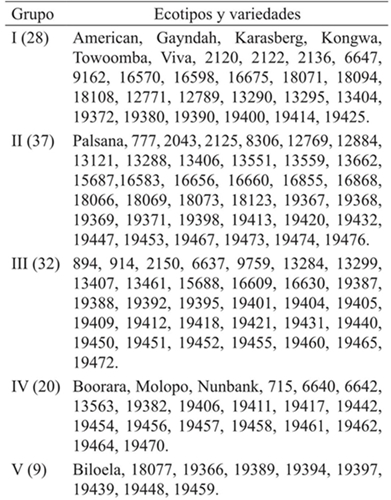Serviços Personalizados
Journal
Artigo
Indicadores
-
 Citado por SciELO
Citado por SciELO -
 Acessos
Acessos
Links relacionados
-
 Similares em
SciELO
Similares em
SciELO
Compartilhar
Revista mexicana de ciencias agrícolas
versão impressa ISSN 2007-0934
Rev. Mex. Cienc. Agríc vol.8 no.1 Texcoco Jan./Fev. 2017
https://doi.org/10.29312/remexca.v8i1.68
Articles
Forage characterization of ecotypes of buffel grass under temporary conditions in Debre Zeit, Ethiopia
1Universidad Autónoma de Chihuahua- Facultad de Zootecnia y Ecología. Periférico Francisco R. Almada, kilómetro 1. Chihuahua, Chihuahua, México. CP. 31000. Tel. 614 1320298.
2Campo Experimental Zacatecas-INIFAP. Carretera Zacatecas-Fresnillo, km 24.5. Calera de V. R., Zacatecas. CP. 98500.
3ILRI- Forage Diversity, Addis Ababa, Ethiopia, PO. Box 5689.
4Campo Experimental Campana-Madera-INIFAP. Carretera Chihuahua-Oginaga, km 33.3.
5Campo Experimental Verdileño- INIFAP. Av. Insurgentes Núm. 1050. Col. Menchaca Tepic, Nayarit, México.
The variability in forage yield and quality of 126 buffel grass ecotypes [Pennisetum ciliare (L.) Link] was evaluated under temporal conditions in Debre Zeit, Ethiopia. The average annual rainfall is 850 mm. The experimental unit was a 5 m long furrow with 0.4 m between plants. The variables evaluated were: forage production (PF), plant height (AP), leaf length and width (LH and AH), number of stalks (NT), crude protein (PC), acid and neutral detergent fiber (FDN y FDA) and in vivo digestibility of organic matter (DIVMO). The correlation analysis, main components, cluster analysis, discriminant analysis and multivariate analysis of variance (Manova) were performed. The maximum and minimum values that were observed were: FP of 1 302.37 to 7 442.7 kg MS ha-1, AP of 47.7 to 104.48 cm, LH and AH of 12.1 to 33.5 cm and 0.45 to 2.06 cm, respectively. The NT fluctuated from 30 to 125, FDN and FDA from 65.3 to 73.79% and 31.8 to 44.5%, respectively, and DIVMO from 67.9 to 80.67%. A direct linear correlation between PC and DIV was presented (rxy=0.75; p< 0.0001). The first three components explained more than 76% of the total variation described by the nine variables. It was found that eight ecotypes and one variety were those that presented greater production potential and forage quality for temporal conditions.
Keywords: diversity; forage grass; forage quality; phenotype
Se evaluó la variabilidad del potencial de producción y calidad del forraje de 126 ecotipos de zacate buffel [Pennisetum ciliare (L.) Link], de temporal en Debre Zeit, Etiopía. La precipitación media anual es de 850 mm. La unidad experimental fue un surco de 5 m de longitud con 0.4 m entre plantas. Las variables evaluadas fueron: producción de forraje (PF), altura de planta (AP), largo y ancho de hoja (LH y AH), número de tallos (NT), proteína cruda (PC), fibra detergente neutro y acida (FDN y FDA) y digestibilidad in vivo de la materia orgánica (DIVMO). Se realizó análisis de correlación, componentes principales, análisis de agrupamiento, análisis discriminante y análisis multivariado de la varianza (Manova). Los valores máximos y mínimos fueron: PF de 1 302.37 a 7 442.7 kg MS ha-1, AP de 47.7 a 104.48 cm, LH y AH de 12.1 a 33.5 cm y 0.45 a 2.06 cm, respectivamente. El NT fluctuó desde 30 hasta 125, FDN y FDA de 65.3 a 73.79% y 31.8 a 44.5%, respectivamente y DIVMO de 67.9 a 80.67%. Se presentó una correlación lineal directa entre PC y DIV (rxy= 0.75; p< 0.0001). Los tres primeros componentes explicaron más de 76% de la variación total descrita por las nueve variables. Se encontró que ocho ecotipos y una variedad fueron los que presentaron mayor potencial de producción y calidad de forraje para condiciones de temporal.
Palabras clave: calidad forrajera; diversidad; fenotipo; pasto forrajero
Introduction
In extensive livestock, the diversity of forage resources represents the main source of feed for livestock. Maintaining and conserving biodiversity is important, since its loss would lead to food problems, both animal and human (Heywood, 2008). In addition, it has been estimated that the African continent will be more susceptible to the effects of climate change and in particular, will have significant impacts on populations of native species (Hoffman and Vogel, 2008). An important perennial species in African grasslands is the buffel grass [Pennisetum ciliare (L.) Link]. In this country there is great genetic variability and is considered the center of origin of several species of this genus (Gutiérrez-Ozuna et al., 2009; Burson et al., 2012).
The buffel grass is a C4 growth grass and is one of the best forage grasses in the subtropics of Africa. It is widely used in arid, semi-arid and desert regions of the world (Dixon and Coates, 2010; Carvalho de Silva et al., 2011; Marshall et al., 2012). It is characterized by good forage production (Gómez de la Fuente et al., 2007), avoids soil erosion (Bhattarai et al., 2008) and is tolerant to drought (Quiroga et al., 2013).
The grass buffel grows well on flat terrain with soft hills and deep soils with good drainage. It adapts to a wide range of soil types, with a pH from neutral to slightly alkaline (Marshall et al., 2012); however, there are varieties or ecotypes with high tolerance to alkaline soils (Griffa et al., 2010). The optimum temperature for development is 35 °C with a range of 20 to 45 °C; however, it has been reported that it tolerates 50 °C (De la Barrera and Castellanos, 2007). It is considered a grass with low frost tolerance but plants die at temperatures equal to or lower than -2 °C (Ludlow, 1980). It is well established in regions where precipitation maintains a range ranging from 150 to 700 mm (Ward et al., 2006).
Jorge et al. (2008), characterizing in agro-morphological descriptors of 68 ecotypes of buffel grass, in Ethiopia suggested to evaluate the diversity of this species in temporal conditions and to identify ecotypes with good forage potential for their livestock use. In addition, there is a germplasm bank in Ethiopia belonging to ILRI (International Livestock Research Institute), which has 126 ecotypes of buffel grass. Due to the above, the present research was proposed, whose objective was to evaluate the variability in the production potential and forage quality of 126 ecotypes of buffel grass, under temporary conditions in Debre Zeit, Ethiopia.
Materials and methods
This research was carried out at the Debre Zeit Experimental Station of the International Livestock Research Institute (ILRI) in Ethiopia, Africa. The site is located 56 km southwest of the capital of Addis Ababa at coordinates 8° 44’ north latitude and 30º 58’ E. The altitude is 1 850 m. The average annual precipitation is 850 mm with a higher presence in the months of june to september, but in 2014 only 86.6% (499 mm) was recorded than expected (Figure 1). The soil type is vertizol with a pH of 7. In an ex situ germplasm bank located at the ILRI of Zwai Experimental Station, 126 ecotypes and buffel grass varieties were selected. From each plant, one-inch diameter clones were selected and transplanted on kune 25, 2014, under a randomized complete block experimental design. Three replicates were used in furrows of 0.75 m wide by 5 m long, based on the methodology recommended by Morales (2009).
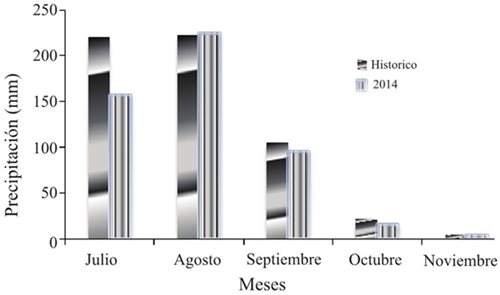
Figure 1 Historical monthly average precipitation (mm)(1951-2003) and monthly of 2014 at the Debre Zeit Experimental Station, Ethiopia, Africa.
In spice plants at 0.4 m and with a total of 12 plants per row, the eight plants were used to measure descriptors. The first cut was given two months after the transplant to homogenize plots and were kept in temporary conditions. The 200 kg of nitrogen and 60 kg of ha-1 phosphorus were applied. The seeds used came from Botswana, DR Congo, Ethiopia, Kenya, Mauritania, Namibia, Nigeria, Somalia, South Africa, Tanzania, Uganda, Zimbabwe.
In addition were included varieties, American, Biloela, Boorara, Gayndah, Karasberg, Nunbank, Towoomba, Kongwa, Palsana and Viva (Table 1).
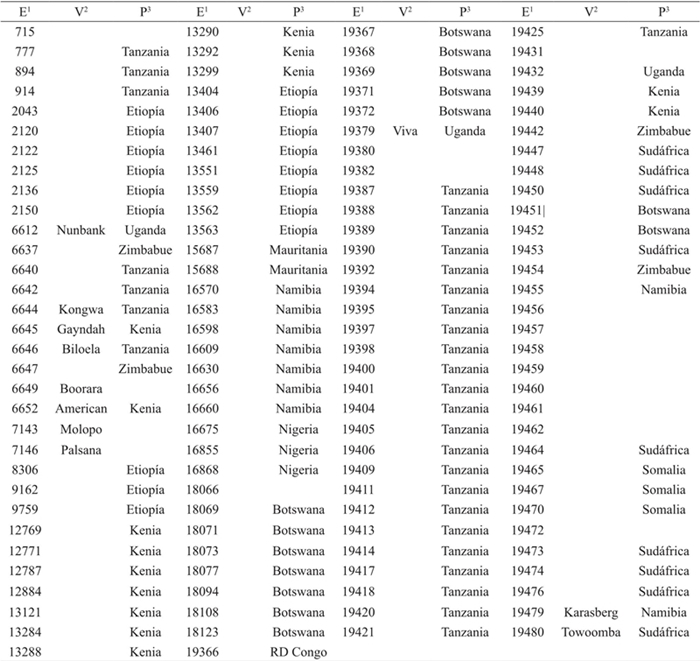
Table 1 Origin data of ecotypes and varieties of buffel grass (Pennisetum ciliare), used for characterization.
To evaluate the variables, two cuts were made: the first one at 45 d after the homogenization cut (october 7, 2014) and the other at 45 days after the first cut (november 11, 2014). The variables were: forage production (PF), plant height (AP), leaf length (LH), leaf width (AH) and number of stems (NT). For forage production the useful plot was cut to 10 cm from the ground, weighed and 300 g of sample were taken. These were placed in a forced air oven for 72 h at 60 °C for drying and to determine the percentage of dry matter. With the green forage weight and the dry matter content, PF was determined. The AP was measured from the soil level to the tip of the inflorescence in three plants of the useful plot of each replicate.
For LH and AH, the second or third leaf was selected under the flag leaf and for LH the measurement was from the ligule to the tip of the leaf. For AH, the central part of the leaf of the three plants was measured per repetition where the heights were determined. Three days after cutting three tillers were selected from the plot and NT harvested was counted. The forage samples were ground in the ILRI Nutrition Laboratory and stored in paper bags. For the bromatological analysis, the NIRS® (Near Infrared Reflectance Spectroscopy; Park et al., 1998) and the variables obtained were crude protein (PC), neutral detergent fiber and acid (FDN and FDA) and in vivo digestibility of organic matter (DIVMO).
In order to observe relations between variables, the Pearson correlation coefficient was estimated and the procedure CORR of the SAS® package was used (SAS, 2006). In addition, a principal component analysis was performed using the PRINCOMP procedure (SAS, 2006) and a hierarchical cluster analysis using the CLUSTER procedure (SAS, 2006). The grouping method was Ward and groups were chosen based on PSt2 (pseudo-statistical t2). Also, to determine the variables with the highest discriminant power, the STEPDISC procedure was used (SAS, 2006) and a discriminant function was analyzed through the DISCRIM procedure (SAS, 2006) to determine the probability of an ecotype belonging to its group. Finally, a multivariate analysis of the variance (MANOVA) was performed to observe if there were differences (p< 0.05) between groups, the reference was the Lambda statistic of Wilks.
Results and discussion
The 126 ecotypes of buffel grass presented wide diversity in agronomic, morphological and nutritional descriptors. The forage production ranged from 1 302.37 to 7442.7 kg MS ha-1 and was the variable with the highest standard deviation with 1 288.45 kg MS ha-1. The second variable was NT with a range from 30 to 125, with a standard deviation of 21 stems. The ranges obtained in AH ranged from 0.45 to 2.06 cm and their standard deviation was 0.18 cm. Also, the crude protein showed a range from 12.7 to 17.6% with a standard deviation of 0.94% (Table 2).

Table 2 Mean, maximum and minimum value, variance and standard deviation of the buffel collection (Pennisetum ciliare).
These forage yields are congruent with those reported in different agronomic regions of Mexico, where yields are reported from 1.2 to 11.4 t ha-1 (Mariano et al., 2011; Peña del Río et al., 2011; Terrazas and Chávez, 2011). Pengelly et al. (1992) studied 322 ecotypes of buffel grass and reported plant heights ranging from 44 to 116 cm, which were similar to those obtained in this research. With respect to leaf length and width, the results coincide with those reported in one study, where they evaluated the diversity of 68 ecotypes of buffel grass (Jorge et al., 2008) and obtained leaf lengths of 1.5 to 30 cm and width of sheet from 3 to 8 mm.
When analyzing the nutritional characteristics of these ecotypes of buffel grass during the growth stage, different results were obtained from other research papers, since for PC the reported ranges fluctuated from 6 to 9%, DIVMO from 55 to 60%, FDN from 73.7 to 76% and FDA from 46.05 to 47% (Jacobs et al., 2004; Carvalho de Silva et al., 2011). These low nutritional values reported are probably due to the lower fertilization rate used. However, these results represent a good opportunity for inclusion in a genetic improvement program.
The correlation analysis (Table 3) revealed significant relationships (p< 0.05) between the variables. The forage production (PF) was positively associated with plant height (AP; rxy= 0.66) and leaf length (LH; rxy= 0.62). In addition, plant height was positively associated with LH (rxy= 0.58).

Table 3 Coefficient of correlation between agronomic, morphological and nutritional variables of 126 ecotypes of buffel grass (Pennisetum ciliare).
Also, the correlation coefficient between crude protein and DIVMO showed a high positive relation (rxy= 0.75). However, PC was negatively related to FDA (rxy= -0.596) and for FDN this was found to be positive with FDA (rxy= 0.62). According to the above, Jorge et al., 2008 reported a positive association between AP and LH in buffel grass.
As regards nutritional characteristics, Jacobs et al. (2004) reported that in increments of PC the digestibility in vivo increases and is observed a decrease in FDN. These results are congruent with those obtained in this research, since they show that ecotypes with higher plant height and longer leaf length tend to produce more fodder. However, materials with higher percentage of crude protein, contain less FDA and therefore are more digestible.
The principal components analysis (ACP) showed that the first three explained 76% of the agronomic, morphological and nutritional variation observed in the 126 ecotypes of buffel grass. When the correlation coefficient (r) was obtained, the variables that were positively associated with CP1 were: plant height, crude protein and in vivo digestibility of organic matter, while neutral and acid detergent fiber were negatively associated. In CP2, variables such as dry and long forage and leaf width were related, however, CP3 grouped only the number of stems (Table 4).
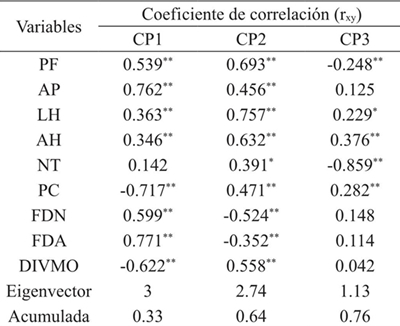
Table 4 Correlation of variables with respect to the main components and the contribution of the variance in 126 ecotypes of buffel grass (Pennisetum ciliare).
The variables grouped by CP1 relate to the nutritional value of the buffel ecotypes. Therefore, this component reflects a high index of nutritional quality in these materials. The CP2 includes variables related to biomass production, therefore, this component reflects an index of forage potential in these ecotypes. This behavior, which showed the main components, is similar to works performed by M’Seddi et al. (2002) and Griffa et al. (2012) in populations of buffel grass. In addition, Morales et al. (2009) in evaluating the diversity of 173 ecotypes of Bouteloua gracilis report that the variables of greatest contribution in explaining the morphological variation were yield of forage, stem density and forage height.
In the Figure 2 shows the distribution of the buffel ecotypes in the first two main components. It is observed that in the quadrant I are positioned ecotypes with higher production of forage and with low content of PC. The ecotypes present in the quadrant II are characterized by being materials with forage production and low digestibility. The ecotypes located in the III quadrant are characterized by having the lowest stem density and higher crude protein content. Finally, in the IV quadrant ecotypes were found that contain the highest values of PC and DIVMO.
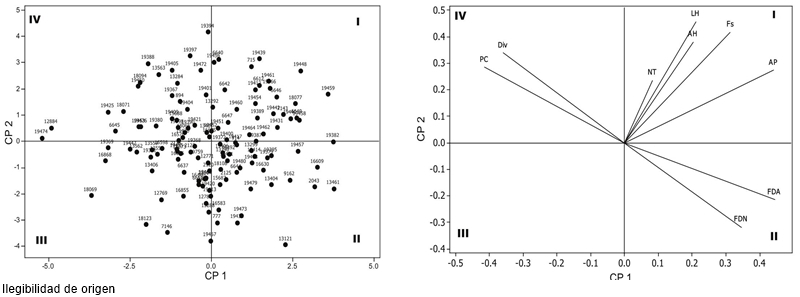
Figure 2 Distribution of the diversity of 126 ecotypes of buffel grass (Pennisetum ciliare) with nine variables depending on the first two main components. PF= Forage production; AP= plant height; NT= number of stems; LH= leaf length; AH= leaf width;PC= crude protein; FDN = neutral detergent fiber; FDA= acid detergent fiber; DIVMO= in vivo digestibility of organic matter
With the hierarchical grouping using the Ward linkage method, it integrated five large groups (Figure 3). In the Table 5, MANOVA ratified the previous one by means of the statistic of Lambda of Wilks᾿ that showed statistical multivariate difference between groups (p< 0.0001).
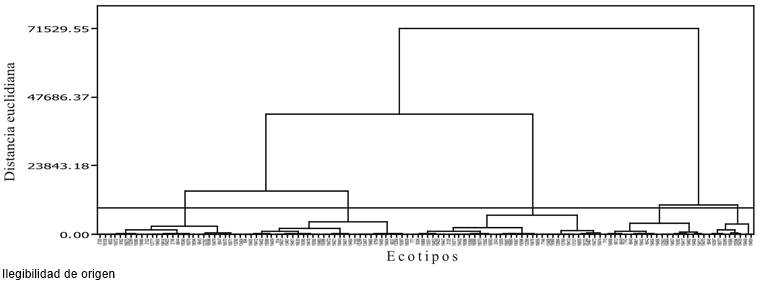
Figure 3 Dendogram of the nine-variable analysis for the 126 ecotypes of buffel grass (Pennisetum ciliare).
The group I integrated 28 materials of which 22 are ecotypes and the rest of varieties American, Gayndah, Karasberg, Kongwa, Towoomba and Viva. These materials were characterized by medium-low forage yields, as the average forage yield was 3.126 kg MS ha-1, with a standard deviation of 196 kg. The mean plant height in this group was 69.76 cm, with a leaf length and width of 21.31 and 0.81 cm, respectively. The number of stems averaged 79. The crude protein averaged 14.8%. For neutral and acid detergent fiber the averages were 68.7 and 39.1%, respectively. Finally, in vivo digestibility maintained an average of 72.8% in the group.
The group II consisted of 37 ecotypes of which only the Palsana variety was present. This group was characterized by having the lowest forage production, since the average yield was 2 176 kg MS ha-1. In addition, this group had the lowest number of stems, 55 per tillering. However, it was the group with the highest crude protein content (15%). Plant height averaged 63.2 cm, with a leaf length and width of 19.04 and 0.75 cm, respectively. In neutral and acid detergent fiber values on average were 68.9 and 39.2%, respectively. Finally, in vivo digestibility was 73.3%.
The group III included 32 ecotypes that presented mean values of forage production (3n 881 kg MS ha-1). The average plant height was 75.16 cm, with a leaf length and width of 22.59 and 0.89 cm, respectively. The density of stems per tiller was 77 per plant. The average crude protein content was 14.93%. Neutral and acid detergent fiber obtained values of 68.9 and 39.5%, respectively. Finally, in the in vivo digestibility was recorded an average value of 73.96%.
The group IV consisted of 20 ecotypes, characterized by medium-high yield, with an average forage yield of 5.048 kg MS ha-1. This group obtained relatively high values (79.15, 26.13 and 0.95 cm) in AP, LH and AH, respectively. The stems density in this group maintained an average of 76. The mean crude protein content was 14.49%. The neutral and acid detergent fiber maintained mean values of 68.7 and 39.1%, respectively. Finally, in vivo digestibility averaged 72.8%. In this group were located 17 ecotypes and the varieties Boorara, Molopo and Nunbank.
The group V included nine ecotypes of which and the Biloela variety. This group was characterized by having the highest materials in forage production, since the average yield was 6 374 kg MS ha-1. This group had the highest plant size (84.5 cm), the largest leaf length (28.21 cm) and leaf width (0.97 cm). Also, it presented the highest density of stems (92) per tillering. The average crude protein content was 14.84% and the highest percentage (74.2%) of digestibility in vivo (Table 5). The results of group I agree with those reported by Pengelly et al. (1992) characterizing 322 buffel ecotypes, where the American and Gayndah varieties were integrated. The descriptors that presented similar characteristics were plant height and number of rhizomes. In addition, Cook et al. (2005) mentioned that the American and Gayndah varieties are characterized by a good grazing response and high animal load. Therefore, the ecotypes that comprised the groups I and II could represent an alternative for their consideration in programs of planting in grasslands.Griffa et al. (2012) evaluated the relationship between seed yield and morphological characteristics of varieties and buffel ecotypes, grouped the varieties Boorara, Molopo and Biloela, which were characterized by having an intermediate spike weight, while the varieties Toowomba and American presented the lowest weight of spikes.
The previous results are congruent with the behavior of some varieties integrated by group I and IV. Therefore, varieties and ecotypes of group IV can be considered as dual-purpose materials (seed and forage production). In addition, Hacker et al. (1995) evaluated forage production in different varieties and buffel ecotypes and the results obtained were in agreement with those obtained in this work, since the American and Gayndah varieties were located in the group of low forage yield. Also, this author reported that the Molopo variety surpassed Biloela; however, they are maintained in the groups of higher forage production.
The ecotypes and varieties located in groups IV and V can be recommended for the production of cut or forage hay. However, it would be important to continue their evaluation for at least two more years to validate the stability of their productive behavior. Due to the above, it is necessary to perform work on seed quality and quality to complement and have an elite collection of buffel grass.
It was observed that the variables with greater discriminant power (p< 0.0001) were forage production, plant height and stem density (Table 6). This technique is appropriate in forage species, since it identifies and separates the groups according to the identified descriptors (Ubi et al., 2003). Jorge et al. (2008) evaluating 22 morphological descriptors in 68 buffel grass ecotypes, failed to identify variables with discriminant power. The variables with discriminant power in Chloris gayana ecotypes were forage yield and percentage of leaf in plant (Ponsens et al., 2010).
Conclusions
The ecotypes 18077, 19366, 19389, 19394, 19397, 19439, 19448, 19459, were identified, with provenances from Botswana, RD Congo, Tanzania, Tanzania, Tanzania, Kenya, South Africa and the Biloela variety as the most productive and Forage quality for temporal conditions. There is a great diversity of agronomic, morphological and nutritional characteristics in the collection of ecotypes preserved in the ILRI of Germplasm Bank in Ethiopia, Africa. This genetic wealth of buffel grass represents an opportunity to include it in genetic improvement program.
Literatura citada
Bhattarai, S. P.; Fox, J. J. and Gyasi, A. Y. 2008. Enhancing buffel grass seed germination by acid treatment for rapid vegetation establishment on railway batters. J. A. Env. 72:255-262. [ Links ]
Burson, B. L.; Actkinson, J. M.; Hussey, M. A. and Jessup, R. W. 2012. Ploidy determination of buffel grass accessions in the USDA national plant germplasm system collection by flow cytometry. Sou. Afr. J. Bot. 79:91-95. [ Links ]
Carvalho, de S. T.; Loiola, E. R.; Oliveira, M. C. H.; Mauro, S. E.; Soares, de S. D. and Pereira, A. 2011. Morphological and chemical composition of buffel grass at different heights of cutting and waste. Rev. Tróp. Cienc. Agr. Biol. 5:30-39. [ Links ]
Cook, B. G.; Pengelly, B. C.; Brown, S. D.; Donnelly, J. L.; Eagles, D. A.; Franco, M. A.; Hanson, J.; Mullen, B. F.; Partridge, I. J.; Peters, M. and Schultze, K. R. 2005. Tropical forages: an interactive selection tool. [CD-ROM], CSIRO, DPI and F(Qld), CIAT and ILRI, Brisbane, Australia. [ Links ]
De la Barrera, E. and Castellanos, A. E. 2007. High temperature effects on gas exchange for the invasive buffel grass (Pennisetum ciliare [L] Link). W. Biol. M. 7:128-131. [ Links ]
Dixon, R. M. and Coates, D. B. 2010. Diet quality estimated with faecal near infrared reflectance spectroscopy and response to N supplementation by cattle grazing buffel grass pasture. Anim. F. Sci. Tec. 58:115-125. [ Links ]
Goméz, de la F. E.; Díaz, S. H.; Saldivar, F. A.; Briones, E. F.; Vargas, T. V. and Grant, W. E. 2007. Patrón de crecimiento de pasto buffel (Pennisetum ciliare (L.) Link) en Tamaulipas, México. Rev. Tec. Pec. Méx. 45:1-17. [ Links ]
Griffa, S.; Ribbota, A.; López, C. E.; Tomassino, E.; Carloni, E.; Luna, C. and Grunberg, A. 2010. Evaluation seedling biomass and its components as selection criteria for improving salt tolerance buffel grass genotypes. J. Bri. Gras. Soc. 65:358-361. [ Links ]
Griffa, S.; Quiroga, M.; Ribotta, A.; López, C. E.; Carloni, E.; Tommasino, E.; Luna, C. and Grunberg, K. 2012. Relationship between seed yield and its component characters in Cenchrus spp. Elec. J. Plant. Sci. 3:701-706. [ Links ]
Gutierrez, O. R.; Eguiarte, L. E. and Molina, F. 2009. Genotypic diversity among pasture and roadside population of the invasive buffel grass (Pennisetum ciliare L. Link) in north western Mexico. J. Ari. Env. 73:26-32. [ Links ]
Hacker, J. B.; Williams, R. J. and Coote, J. N. 1995. Productivity in late winter and spring of four cultivars and 21 accessions of Cenchrus ciliaris and Digitaria eriantha cv. Premier. Trop. Grass. 29:28-33. [ Links ]
Heywood, V. H. 2008. Challenges of in situ conservation of crop wild relatives. Turk. J. Bot. 32: 421-432. [ Links ]
Hoffman, T. and Vogel, C. 2008. Climate change on African Rangelands. Rang. 30(3):12-17. [ Links ]
Jacobs, S. S., W. A. van Nieker and R. J. Coertze. 2004. Qualitative evaluation of Cenchrus ciliaris cv. Molopo and Gayndah as foggage. Sou. Afr. J. Anim. Sci. 34:65- 68. [ Links ]
Jorge, M. A. B.; Van de Wouw, M.; Hanson, J. and Mohammed, J. 2008. Characterization of a collection of buffel grass (Cenchrus ciliaris). Trop. Grass. 42:27-39. [ Links ]
Ludlow, M. M. 1980. Stress physiology of tropical pasture plants. Trop. Grass. 14:136-145. [ Links ]
Mariano, F. C.; Garza, R. D. C.; Flores, J. T.; Zárate, P. F. e Ibarra, M. A. H. 2011. Evaluación de materiales alternativos al buffel común en San Fernando, Tamaulipas, México. In: memorias del segundo congreso internacional de manejo de pastizales y XXI reunión internacional sobre producción de carne y leche en climas cálidos. Chihuahua, Chihuahua, México. 44 p. [ Links ]
Marshall, V. M.; Lewis, M. M. and Ostendorf, B. 2012. Buffel grass (Cenchrus ciliaris) as an invader and threat to biodiversity in arid environments: A review. J. A. Env.78:1-12. [ Links ]
Morales, N. C. R. 2009. Metodología para la recolecta y conservación de germoplasma de plantas forrajeras en la zonas áridas y semiáridas de México. Sitio Experimental Campana-Madera. INIFAP-SAGARPA. Chihuahua, Chihuahua, México. Folleto técnico. 21:1-21. [ Links ]
Morales, C.; Madrid, L.; Melgoza, A.; Martínez, M.; Arévalo, S.; Rascón, Q. y Jurado, P. 2009. Análisis morfológico de la diversidad de pasto navajita [Bouteloua gracilis (Willd. ex Kunth) Lag. ex Steud], en Chihuahua, México. Téc. Pecu. Méx. 47:245-256. [ Links ]
M´Seddi, K.; Visser, M.; Neffati, M.; Reheul, D. and Chaïeb, M. 2002. Seed and spike traits from remnant population of Cenchrus ciliaris L. in South Tunisia: high distinctiveness, no ecotypes. J. A. Env. 50:309-324. [ Links ]
Park, R. S.; Agnew, R. E.; Gordon, F. J. and Steen, R. W. J. 1998. The use of near infrared reflectance spectroscopy (NIRS) on undried samples of grass silage to predict chemical composition and digestibility parameters. Anim. F. Sci. Tech. 72:155-167. [ Links ]
Pengelly, B. C.; Hacker, J. B. and Eagles, D. A. 1992. The classification of a collection of buffel grass and species. Trop. Grass. 26:1-6. [ Links ]
Peña del Río, M. A.; Días, F. A.; De la Fuente, S. H.; Sánchez, S. A. y de la Torre, T. I. 2011. Efecto de la biofertilización en praderas de temporal de pasto buffel var. Milenio en Nuevo León, México. In: memorias del 2o congreso internacional de manejo de pastizales, y XXI reunión internacional sobre producción de carne y leche en climas cálidos. Chihuahua. México. 421 p. [ Links ]
Ponsens, J.; Hanson, J.; Schellberg, J. and Moeseler, B. M. 2010. Characterization of phenotypic diversity, yield and response to drought stress in a collection of Rhodes grass (Chloris gayana Kunth) accessions. Field Crops Res. 118:57-72. [ Links ]
Quiroga, M.; Grunber, K.; Ribotta, A.; Lopez, C. E.; Carloni, E.; Tommasino, E.; Luna, C. and Griffa, S. 2013. Obtaining sexual genotypes for breeding in buffel grass. Sou. Afr. J. Bot. 88:118-123. [ Links ]
SAS (Statistical Analysis System) . Institute Inc. 2006. SAS 91.3 User´s guide. Cary, North Carolina, Unites States of America. Visit: http://www.support.sas.com/bookstore or call 1-800-727-3228. [ Links ]
Terrazas, P. J. G. y Chávez, M. C. 2011. Rendimiento y calidad de semilla de materiales sobresalientes de zacate buffel en condiciones de temporal en la zona centro sur de Chihuahua. In: memorias del 2do congreso internacional de manejo de pastizales y XXI reunión internacional sobre producción de carne y leche en climas cálidos. Chihuahua, México. 65 p. [ Links ]
Ubi, B. E.; Kolliker, R.; Fujimori, M. and Komatsu, T. 2003. Genetic diversity in diploid cultivars of Rhodesgrass determined on the basis of amplified fragment length polimorphism markers. Crop. Sci. 43:1516-1522. [ Links ]
Ward, J. P.; Smith, S. E. and McClaran, M. P. 2006. Water requirements for emergence of buffel grass (Pennisetum ciliare). W. Sci. 54:720-725. [ Links ]
Received: January 2017; Accepted: February 2017











 texto em
texto em 

